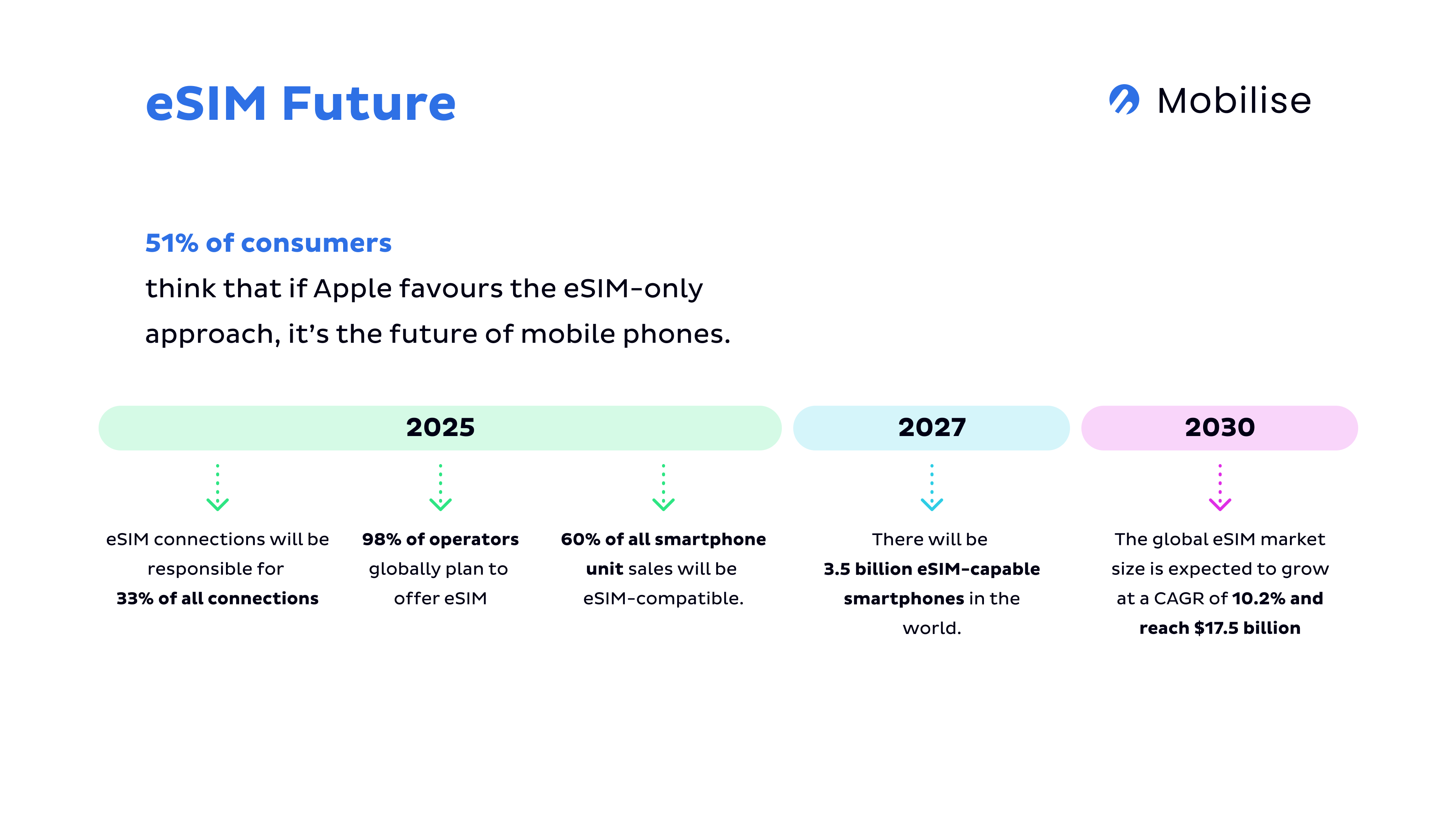As technology continues to evolve at an unprecedented pace, the telecoms industry stands at the forefront of innovation. Shaping the way we connect and communicate. In an era defined by rapid technological advancements, staying attuned to industry trends has never been more crucial.
This blog will focus on key themes that are steering the course of telecoms in 2023. Including the monetisation of 5G, market consolidation, the surging growth of eSIM technology, and the expanding frontier of satellite connectivity.
Join us as we unravel the intricacies of an industry where innovation is not just a constant but a driving force propelling us into the future!
Monetising 5G: Unravelling the Challenges
In last year’s annual review, we suggested that doubts were starting to creep in about the monetisation opportunities with 5G. A year on and the story is much more straightforward. Monetising 5G has proven to be a complex endeavour, marked by a myriad of challenges that demand a nuanced understanding. And the challenges are clearer than before.
5G infrastructure has required massive investment to date, and this is only the tip of the iceberg. According to a report from the GSM Association, global MNOs are expected to invest around $480 billion in mobile CAPEX between 2020 and 2025, with over 80% being 5G-specific.
On top of this, the primary features of 5G aren’t as easily translated into direct consumer benefits or monetisable services. For the vast majority of users, 4G is perfectly sufficient for their needs. A study conducted by Ericsson found that only 34% of consumers believe there’s a genuine difference between 4G and 5G in terms of performance.
RECOMMENDED READING
5G's Uncertain Path: Are MNOs Facing a Profitability Crisis?
Monetisation strategies
The development of 5G in the industry is still ongoing. However, MNOs need to think beyond traditional service-based revenue models to be able to succeed. Exploring B2B or B2B2C avenues is the best place to start, such as:
- Industry Partnerships – Collaborations with industries like automotive for autonomous vehicles, healthcare for telemedicine, or manufacturing for smart factories can open new revenue streams.
- Network-as-a-Service – Leveraging the power of network slicing to offer customised network solutions to different sectors.
- Software Innovation in the BSS Layer – Software innovations in this domain can be pivotal for MNOs as they seek monetisation opportunities in the 5G era.
While the perceived diminishing advancements between generations might be a hurdle. It also represents an opportunity for MNOs to innovate, explore new avenues, and redefine their monetisation strategies for the future. Something that is needed to ensure the success of 5G in 2024 and onwards.
Market Consolidation: European Telecoms in Transition
The European telecoms sector is undergoing a significant shift marked by ongoing market consolidation, with the recent announcement of the merger between Three UK and Vodafone UK taking centre stage. This is driven by the recognition of insufficient scale to support the substantial investments required for robust 5G rollouts, which stands as a key focal point.
UK
Following a recent Parliament session, it was highlighted that 90% of the free cash flow generated by mobile operators in the UK market goes to EE and Virgin Media O2. While the remaining 10% goes to Vodafone, leaving Hutch generating negative cash flow. Without the merger, it’s argued that neither Vodafone nor Hutch as stand-alone businesses would be able to sufficiently invest in 5G network buildout.
However, many also believe that the proposed merger could bring more risk than rewards, especially to consumers. A trade union has argued that mobile phone bills could rise by as much as £300 a year with the reduced competition.
Another key driving factor in the consolidation is due to the significant investment required to play and own infrastructure. Both in the fixed and mobile domains. BT and EE were the first in the UK to consolidate back in 2016. Giving them leverage over Openreach’s vast fixed network as well as EE’s market-leading 4 and 5G mobile services.
Europe
Regulatory dynamics are evolving in favour of consolidation, with regulators in Brussels and the UK exhibiting a more flexible approach towards 4 to 3 mobile network operator (MNO) market consolidations.
In Spain, Vodafone has announced that it has entered into binding agreements with Zegona Communications concerning the sale of Vodafone Spain. Whereby Vodafone will provide certain services to Vodafone Spain for a total annual service charge of c.€110 million.
Looking forward, it seems that further market consolidation is imminent as the economics of 5G pose increasing challenges for smaller MNOs. With substantial investments and potentially low returns, smaller players in the industry must carefully navigate the evolving landscape. Considering the implications of market consolidation on their competitive standing and strategic positioning.
eSIM Driving Growth: Transforming Business Models
eSIM technology has become a cornerstone in reshaping the landscape of the telecoms industry, ushering in transformative changes that extend beyond conventional business models.
One of the standout effects of eSIM technology has been witnessed in the travel industry. Travel eSIMs have experienced substantial growth fuelled by the convenience and flexibility it afford consumers. A report by Kaleido Intelligence predicts that the travel eSIM market is set to be worth almost $10 billion by 2028.

Beyond the realms of traditional telecom services, eSIM has given rise to innovative business models, notably through the concept of Embedded Connectivity. This revolutionary approach involves integrating mobile services into non-telco product portfolios, through a product such as Mobilise’s Connectivity SDK. Creating a seamless and interconnected experience for consumers. As a result, new revenue streams are emerging, and businesses are redefining their strategies to adapt to this paradigm shift.
The implementation of mobile connectivity into non-telco product portfolios isn’t only a testament to the versatility of eSIM. But also underscores its potential to permeate diverse industries. Including but not limited to the travel industry and fintech.
RECOMMENDED READING
Embedded Connectivity - A digital gateway to a new revenue stream
eSIM’s future
The future of eSIM is bright. In 2022, the global eSIM market size exceeded $8 billion. It’s expected to grow at a compound annual rate (CAGR) of 10.2%, reaching 17.5 billion by 2030.
Consumer awareness is growing and they’re gravitating towards the convenience that eSIM offers. Traditional telco service providers (SPs) have been reluctant to push the technology for fear of customer churn. Despite the lack of marketing from SPs, device manufacturers have increased the accessibility of eSIM-compatible devices and eSIM-only apps have flooded mobile app marketplaces. A survey conducted by Dynata and Amdocs found that 51% of consumers believe that Apple’s favouring an eSIM-only approach to smartphones indicates the future of mobile phones.

The future promises a continued evolution of connectivity. With eSIM playing a pivotal role in shaping the telecom landscape and offering the untapped potential for both service providers and consumers alike.
Satellite Connectivity: The Rise of LEO Providers
The landscape of satellite connectivity in 2023 is marked by significant advancements, with the spotlight on Low Earth Orbit (LEO) satellite providers making noteworthy strides.
SpaceX’s Starlink is a relatively new player in the satellite sector. But Bloomberg and other outlets reported that the company is set to make $9 billion in revenue and $3 billion in operating profits this year. The success of Starlink can be attributed to its blend of innovative technology and business acumen becoming a market disruptor for satellite internet services.
Not only that, but Amazon also launched their first pair of prototype satellites for its Kuiper internet network in early October. Intending to compete against Starlink, Amazon aims to deploy 3,236 more satellites over the next few years and offer broadband internet globally.
We’ve also seen announcements from many satellite providers who’ve partnered with MNOs. To ‘complement’ existing terrestrial networks with satellite connectivity to reach rural, remote or underserved areas. One of which is Telefónica and Sateliot partnering to combine 5G and LEO satellites to extend the reach of “everywhere-in-the-planet connectivity” for narrowband IoT from 2024.
The integration of LEO satellites into the telecom infrastructure not only extends the reach of networks. But also contributes to bridging the digital divide. Ensuring that even the most remote regions have access to robust and reliable connectivity.
As we navigate the implications of these developments, it becomes evident that the synergy between LEO satellite providers and MNOs holds the potential to revolutionise the telecoms industry and redefine global connectivity standards.
Conclusion
2023 has been an eventful year for the industry – further mergers, revenue model evolutions and technological advancements. As more pieces fall into place and more changes happen, it’ll be very interesting to see what happens in 2024. But what’s more important than ever, is that we continue to stay informed and adapt to changes within this incredibly dynamic industry.



